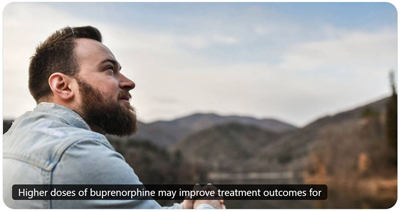NIH-funded analysis suggests higher doses of buprenorphine were associated with lower rates of future behavioral health-related emergency department and inpatient care.
September 26, 2024 – Adults with opioid use disorder who receive a higher daily dose of the opioid addiction treatment medication buprenorphine 
Researchers reviewed insurance claims data from over 35,000 people who were diagnosed with opioid use disorder and began buprenorphine treatment between 2016 and 2021. They found that among all people who started treatment with buprenorphine, 12.5% experienced an emergency department or inpatient visit related to behavioral health within the study period. After adjusting for patient demographics and medical history available in the data, researchers then analyzed how long it took for people receiving different doses of buprenorphine to use emergency care or have an inpatient stay after starting treatment.
The recommended target dose for buprenorphine in the U.S. Food and Drug Administration (FDA)’s approved labeling is 16 mg per day. Researchers found that those taking higher daily doses of buprenorphine (>16 to 24 mg) took 20% longer to have a subsequent emergency department or inpatient health care visit related to behavioral health within the first year after receiving treatment, compared to those receiving >8 to 16 mg a day. Those taking daily doses of more than 24 mg of buprenorphine went 50% longer before having a subsequent emergency or inpatient health care visit related to behavioral health within the first year after receiving treatment, compared to those receiving >8 to 16 mg a day.
“As the overdose crisis evolves, particularly with the rise of fentanyl, it is crucial to investigate how to best adapt and deliver the lifesaving and evidence-based treatments for opioid use disorder that we have available,” said Nora D. Volkow, M.D., director of NIH’s National Institute on Drug Abuse (NIDA). “The findings add to the growing evidence that higher doses of buprenorphine may have meaningful health impacts for people with opioid use disorder.”
In 2022, of the nearly 108,000 overdose deaths reported in the U.S., almost 70% were primarily due to fentanyl, a synthetic opioid that is approximately 50 times stronger than heroin. The ubiquity of fentanyl in the drug supply and associated overdose deaths have raised questions about whether existing dosing guidelines for buprenorphine should be modified to better address the unique challenges posed by such a potent opioid. Higher doses of buprenorphine may be necessary to effectively manage the more severe withdrawal symptoms, cravings, and tolerance associated with fentanyl use.
“Preventing or delaying the need for high-intensity, urgent health care among people with opioid use disorder has tremendous benefits on health and recovery,” said Bradley D. Stein, M.D., Ph.D., a study co-author and director of the RAND-USC Schaeffer Opioid Policy Tools and Information Center. “As we continue to gather data across studies, findings suggest that higher doses of buprenorphine may have the ability to significantly improve treatment in the era of fentanyl, as both fatal and nonfatal overdoses remain unacceptably high.”
The authors also note that addressing barriers to accessing higher doses, such as state laws and insurance policies, will be important in ensuring that all patients receive effective care. In addition, revisiting guidelines that serve as barriers to higher doses could be beneficial, as these may limit access to potentially life-saving treatment for patients at high risk of relapse or overdose.
Notably, the data used in the study were pulled from a single commercial insurance company, which does not include uninsured people and those with Medicaid or fee-for-service Medicare coverage, and the sample of people included in the analysis was 75% non-Hispanic white. Further research is needed to explore the effects of higher buprenorphine doses in more diverse populations, including those with different insurance statuses or in different clinical settings. In addition, the authors note that future research should also investigate additional outcomes such as the long-term effects of high-dose buprenorphine on opioid use disorder treatment retention and overall health outcomes using similar data.
These findings build upon accumulating evidence of the safety and efficacy of higher doses of buprenorphine. Studies have shown that more than 16 mg of buprenorphine is safe and well tolerated in people with opioid use disorder in emergency department and outpatient treatment settings, and that higher buprenorphine doses are associated with improved retention in treatment for opioid use disorder.
This study was funded by the NIH’s NIDA and published in JAMA Network Open. The data analyzed in the study came from a large insurer’s database of commercial claims, including those for Medicare Advantage.
If you or someone you know is struggling or in crisis, help is available. Call or text 988 or chat at 988lifeline.org. To learn how to get support for mental health, drug or alcohol conditions, visit FindSupport.gov. If you are ready to locate a treatment facility or provider, you can go directly to FindTreatment.gov or call 800-662-HELP (4357).
About the National Institute on Drug Abuse (NIDA): NIDA is a component of the National Institutes of Health, U.S. Department of Health and Human Services. NIDA supports most of the world’s research on the health aspects of drug use and addiction. The Institute carries out a large variety of programs to inform policy, improve practice, and advance addiction science. For more information about NIDA and its programs, visit www.nida.nih.gov.
About the National Institutes of Health (NIH): NIH, the nation's medical research agency, includes 27 Institutes and Centers and is a component of the U.S. Department of Health and Human Services. NIH is the primary federal agency conducting and supporting basic, clinical, and translational medical research, and is investigating the causes, treatments, and cures for both common and rare diseases. For more information about NIH and its programs, visit www.nih.gov.
NIH…Turning Discovery Into Health®
Reference: S Axeen, et al. Association of daily doses of buprenorphine with urgent health care utilization. JAMA Network Open. DOI: 10.1001/jamanetworkopen.2024.35478 (2024).
Source & photo: NIH








